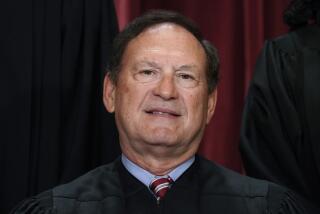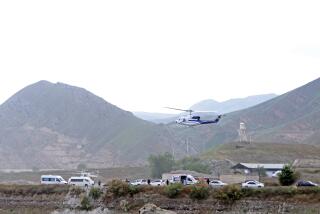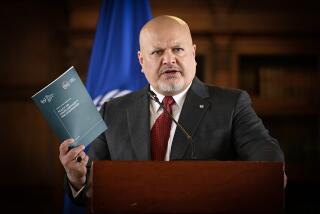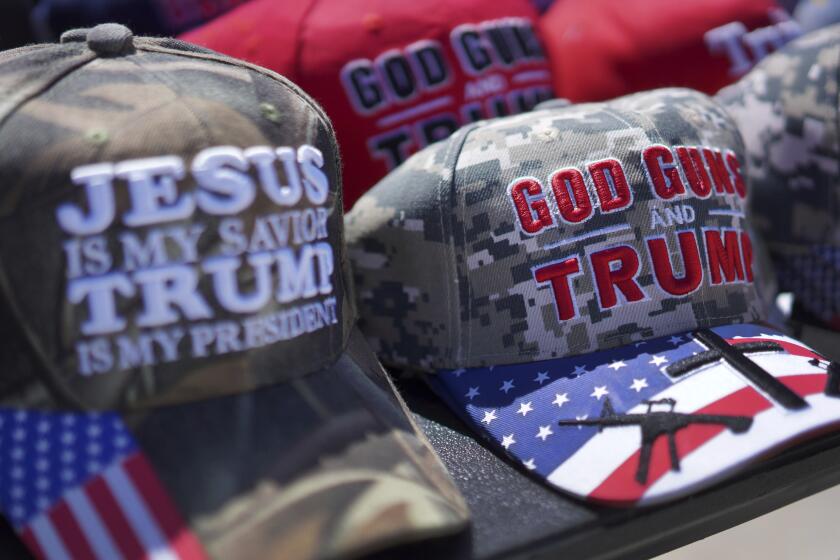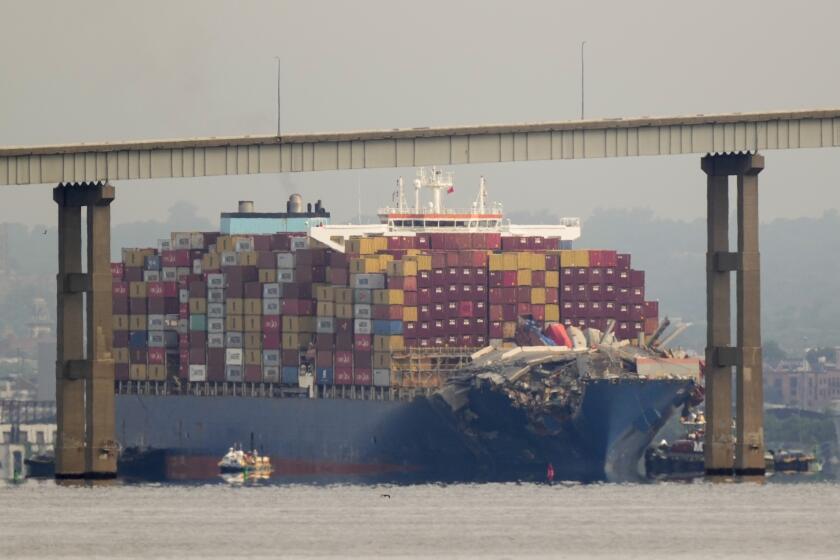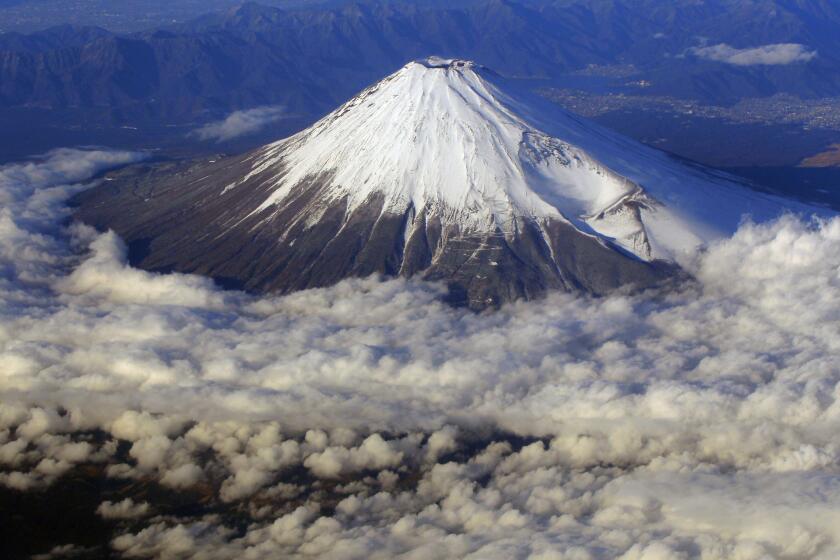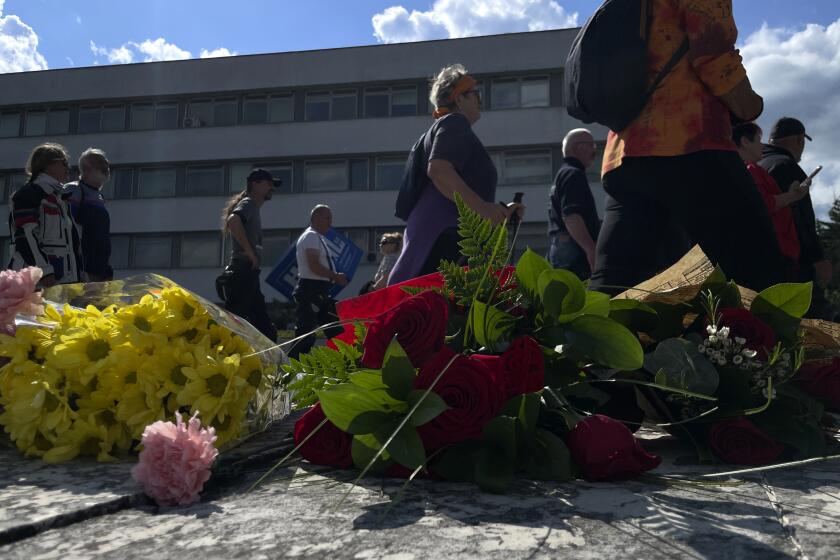The Tough Question Will Always Remain : Two People Forever Tied to the Manhattan Project Sift Through the Never-Ending Debate: Did We Have to Use the Bomb?
Fifty years after the birth of the atomic bomb, the country prepares to commemorate the act that brought World War II to an end. For me, the public debate over the bombing of Hiroshima and Nagasaki mirrors a private one: For most of my life, the bomb has been a personal matter.
During World War II, my father, Harry Palevsky, was an electrical engineer on the Manhattan Project, the massive effort of American academia, government and industry that produced the world’s first nuclear weapon. He met my mother, Elaine Sammel, who had an undergraduate degree in physics, while they worked on the project at the University of Chicago’s Metallurgical Laboratory. They later transferred to the top-secret Los Alamos laboratory in New Mexico, where my father worked on the trigger mechanism that detonated the bomb. My mother worked on the development of optical instrumentation. On a hot day in the summer of 1945, they drove down the mountain to Santa Fe and got married.
In 1990, I was caring for my father after my mother’s sudden death. He had been chronically ill for many years, and in the months before he died I began interviewing him about his life and work for a book of memoirs. One morning when he was talking about the Manhattan Project, I asked what it had been like at Los Alamos after the successful bombing of Hiroshima. My father replied that there had been a lot of mixed feelings among the scientists. Then he hung his head and fell silent.
After a long pause, he looked up at me. With a sob caught in his throat, he asked, “Did you know that Nagasaki was the center of Christianity in Japan?” I said I didn’t.
I cannot tell exactly when my father first questioned the decision to use the atomic bomb, but I had long known of his contradictory feelings about his work on the Manhattan Project. One one hand, it had been a prelude to his career in the field he loved, nuclear physics. But although he felt privileged to have worked alongside some of the century’s greatest scientists to end the war, he was deeply troubled by the terror they created to achieve peace. At that moment, when my father openly shared his grief with me, I felt his effort to reconcile the moral complexities of the bomb was being passed on to me. When he died, it became his legacy.
After the Japanese surrender, my father vowed never to work on weapons again. He would only do science for peaceful purposes. He did his graduate work at the University of Illinois and for more than 30 years was an experimental nuclear physicist at Brookhaven National Laboratory on Long Island, where he conducted research in superconductivity and was a founder of hypernuclear physics. My mother did not pursue science but was active in my father’s career. Together, they raised five children.
Along with many of his Manhattan Project colleagues, my father channeled his sense of responsibility into action as a member of the Federation of American Scientists. He also was a delegate to the Geneva Atoms for Peace conferences in the 1950s and a participant in the Pugwash Conferences on Science and World Affairs, established by Bertrand Russell and former Manhattan Project scientist Joseph Rotblat in 1957.
When I was about 10 years old, I began to understand that my parents had worked on a dangerous weapon that had killed Japanese people who were just like us. My father explained to me that he and my mother had not wanted the bomb to be dropped on the Japanese people. They had supported the idea of a demonstration in an uninhabited area. He told me that if the Japanese had witnessed the nuclear devastation, they might have surrendered. The weapon could have served a noble purpose by ending the war but avoiding the terrible destruction of life, he said.
I recall standing in the living room of our house on Long Island carefully examining the series of photographs that chronicled the first 60 seconds of the nuclear age. My mother’s group at Los Alamos had prepared the photographic equipment for the first atomic bomb test, code-named Trinity, at Alamogordo, N.M., on July 16, 1945. How could the shiny, silvery bubble in the initial frame grow larger until it finally became the huge billow of smoke, ash and dust filling the sky in the final one? In my child’s mind, the mushroom cloud was “the bomb.”I did not understand that the first beautiful, iridescent dome, rising from the flat New Mexican horizon, was the deadly expanding fireball.
Now, as the country remembers the end of World War II, I wanted to understand more clearly the larger context of an event that has always been intimately bound up with my relationship with my parents. The Manhattan Project was, in a sense, the defining moment of their lives. It launched my father’s career and shaped his social conscience. But it also brought an undercurrent of sorrow that was so much a part of him. I wanted to interpret for myself the events that carried so much meaning for my father.
as the head of the los alamos lab’s theoretical physics division, Hans Bethe was crucial to the design and development of the bomb. Although such prominent Manhattan Project figures as J. Robert Oppenheimer, Richard Feynman and Enrico Fermi are no longer living, Bethe, now 89, is still active in both scientific and public policy spheres. Over the years, I have read his articles about scientific discovery, nuclear energy and arms control. I thought that Bethe, as a dedicated participant in the debate about nuclear weapons, would be able to help me.
Born in Germany at the beginning of the century, Bethe experienced first-hand the rise of nationalism after World War I. Because his mother was a Jew, he had, at 27, lost his assistant professorship at Tubingen University in the wake of the first Nazi racial laws. He was among the many scientists, intellectuals and academics who fled Europe as fascism spread. In 1935, he accepted an acting assistant professorship at Cornell University, and in 1943, Oppenheimer asked him to come to Los Alamos.
After the war, Bethe was a co-founder of the Federation of American Scientists, the group my father belonged to, and a leading organizer of scientists concerned about the arms race. He opposed the U.S. rush to develop the hydrogen bomb and supported nuclear test bans and a nuclear freeze. Later, he spoke out against the development of the Strategic Defense Initiative (“Star Wars” ). In 1967, Bethe received the Nobel Prize in physics for his work on nuclear reactions, in particular for discovering the source of energy in stars.
One morning, I picked up the phone and dialed his number at Cornell, where he is now professor emeritus. When I heard Bethe’s deep voice, I was nervous; for someone of my background, Hans Bethe is scientific royalty.
Bethe responded cordially when I introduced myself and told me that although he and my father never met, he remembered corresponding with him. Bethe agreed to a meeting the following month when he made his yearly trip to Caltech to do astrophysics research.
When I entered his office at Caltech, the elderly gentleman greeted me with his unmistakable broad smile, a smile I knew from Manhattan Project photographs. Any notion of frailty vanished when he spoke. His German-accented voice was strong and unwavering.
He listened respectfully and sympathetically as I described my dying father’s grief about the dropping of the bomb. I asked if this was something he regretted and was shocked to hear his emphatic answer: “I do not.” The man who has been called America’s most influential advocate of nuclear disarmament believes that the first use of nuclear armaments was necessary and correct.
I had assumed that Bethe would express some doubts. I believe that the United States should have tried to bring the war to an end through diplomacy and a demonstration of the bomb. I wanted to discount Bethe’s views, but I could not: I knew they were informed by the experience of a long and thoughtful life.
I wanted to talk to him at more length, so the following month I traveled to Ithaca, N.Y., where we continued our conversation. The snow was falling when I arrived at the home Bethe and his wife, Rose, have shared since the war. In the warmth of his living room, the professor methodically set out the logic of his argument. He outlined three alternatives for ending the war in the Pacific: blockade, invasion or the bomb.
He began with a discussion of a blockade. “We had complete superiority in the air and at sea. The Japanese were dependent on the import of oil; in fact, that was probably the reason they attacked Pearl Harbor in the first place. And without oil they couldn’t pursue the war.” A prolonged blockade, he said, would have meant starving the Japanese people.
“The blockade would surely have been successful, but it would have left great resentment in Japan, just as it did in Germany after the First World War. It probably would have caused the same resentment I experienced in the early ‘20s. The German slogan ‘Im Felde unbesiegt--never defeated in the field’was the seed for the Nazi movement. I believe that [President Franklin D.] Roosevelt and the British had this very much in mind when they asked for unconditional surrender. They did not want this kind of talk in either Japan or Germany.” As for an invasion, he agreed with estimates by President Harry Truman and Secretary of War Henry L. Stimson that there would have been 500,000 to 1 million American casualties. “There has been a lot of writing recently that an invasion would have been far less costly than was once stated. I think Truman and Stimson’s statements are likely to be correct.” I asked Bethe about arguments advanced by some historians that there is no evidence that the actual wartime estimates were that high. He replies, “I am convinced that the low estimates of casualties which are now being bandied around are fantasy. After all, we had the experience of the islands [Iwo Jima and Okinawa.] The Japanese would now defend the homeland and the fighting would probably have been even more fierce.”
Although I asked about Allied casualties, Bethe discussed potential Japanese losses. In an invasion, Japan’s military casualties would have been higher than the Allies’and noncombatant deaths would have been tremendous, he said. “If there had been blockade or invasion, the firebombing would have continued. The casualties [from incendiary bombs] in Tokyo were close to those of Nagasaki. We must visualize that there would have been such bombing raids week after week. The casualties and the destruction of these would have been many times those of Hiroshima and Nagasaki.”
Another concern, Bethe noted, was the fate of the thousands of Allied prisoners of war. Recounting the story of South African writer Laurens van der Post, a colonel in the British army who spent 3 1/2 years as a prisoner of the Japanese, Bethe’s voice trembles as he says “Van der Post is convinced that if the war had been ended by an invasion, the prisoners of war all would have been killed.”
Still another problem with an invasion would have been the likelihood of a long-term Soviet occupation force in Japan. “In Yalta, in February, 1945, we begged the Soviets to enter the war in the East. They did so, but only after Hiroshima. I think it was a mistake to ask them, because already at that time, February, 1945, it was clear that we would have the uranium 235 bomb. There was no question that it would work. It was only a question of delivery of material.”
“[The Soviets] wanted to be in, and, of course, conquered Manchuria immediately. Stalin wanted to occupy the northern half of Hokkaido, which is in the home islands . . . [and is] about one-tenth of the [Japanese] population,” Bethe explained. Had there been an Allied invasion, “we would have had the same difficulties there as we had with the Soviet occupation in Germany [and] it would have been a very difficult situation for the Japanese.”
However, Bethe does not believe, as do some critics of the decision, that the bomb was primarily a political weapon aimed at the Soviets and used to establish America’s postwar global dominance. The bomb, he asserts, was used to end the war quickly and save the lives of Allied soldiers.
Many European-born scientists dedicated themselves to the bomb project because they feared a Third Reich made invincible by a Nazi nuclear weapon. Even the pacifist Albert Einstein sent a letter to President Roosevelt in 1939 advocating the establishment of an atomic weapon project. He later considered the letter the great mistake of his life, but nonetheless stated that the German threat had somewhat justified his action.
“We all went to war against Nazi Germany, which we felt was a menace to the world,” Bethe recalled. “After all, the Nazis had taken continental Europe. The refugees from Europe [and] most of the leading American scientists worked with great enthusiasm on something which might win the war against Germany.”
Asked if Germany’s defeat had caused him to reconsider the need for the bomb, he replied that he always believed the use of the bomb to be a foregone conclusion: The goal of the Manhattan Project was to build an atomic weapon for use in the war, whether against Germany or Japan.
Here Bethe disagreed with his friend, the Hungarian-born physicist Leo Szilard, who had been the impetus behind Einstein’s letter. After it became clear that the Germans would lose the war, Szilard argued that the use of a weapon conceived as a defense against a Nazi bomb had to be seriously reconsidered. He was on a committee, headed by German-born Nobel laureate James Franck, that studied the social and political implications of nuclear weapons. One of its conclusions was that the bomb should be demonstrated in an uninhabited area. Szilard, who my father told me had influenced his thinking, and my father’s best friend, the late physicist Donald J. Hughes, were among the seven signers of the report.
Even though some project scientists supported the idea, Bethe never considered it a realistic option. “The demonstration would not have been effective. It probably would have been seen by some [Japanese] military. It was quite unlikely that they would have told the emperor, and the emperor was the key to surrender. Without him, the war would have lasted much longer.
“The Japanese Cabinet had three military and three civilian ministers. Even after Hiroshima, while [the] three civilians were for surrender, [the] three military were still for carrying on. The emperor decided, ‘We surrender. I cannot see that kind of destruction go on, one city after another.’It seems to me that the war could not have been ended by a demonstration.”
So Bethe came to the third alternative: destroying an entire city with a single bomb. He perceives an added dimension to the atomic weapon. “It seemed supernatural. The bomb made it possible for the Japanese to surrender with honor. They could still say, we fought very well, but there was something which was far beyond our control--we had to surrender.”
The totality of the Japanese surrender is Bethe’s final point in support of the decision, noting that there has been no resurgence in militarism since the war’s swift and terrible end.
He summed up, “I have lots of arguments the Japanese were much better off by having the two bombs than they would have been otherwise--either by invasion or by blockade. And this is quite apart from the likelihood that in [the] case of an invasion, the Soviets would have occupied part of Japan.”
His conclusion that the Japanese were better off with the devastating nuclear attacks was difficult for me to accept. I asked him if the bombing of Nagasaki was necessary. “Perhaps not,” he responded. “Half a day before Nagasaki, the emperor decided to surrender. But this decision was not known in Washington. Only after Nagasaki was the decision announced over Tokyo radio.”
I suggested that the Japanese were in shock after Hiroshima and did not have enough time to react before Nagasaki. The second bomb was scheduled to be used unless Truman specifically said, “Don’t drop it.” The President’s command was not needed to drop the bomb but to stop it.
Bethe responded, “You are absolutely right. The second bomb might have been avoided. Unfortunately, the decision to use it wasn’t in Truman’s hands. It may have been a mistake to give the orders in this way, thereby leaving the decision to the commander in the field.”
Tragically, the forward momentum of the great engine of war could not easily be halted. Even after Nagasaki, the firebombing of Japanese cities continued. Bethe reminded me that sanity finally prevailed--a third bomb was at Los Alamos, ready to be transported to the Pacific, when the lab received the order not to ship it.
I told Bethe that we could argue about the decision to drop the bomb from various standpoints; the theologian and the general may interpret the same historical facts differently. But the bomb was terrible. In addition to Hiroshima and Nagasaki, the mushroom cloud has become a symbol of our ability to instantaneously kill each other in vast quantities. I suggested to Bethe that even in the 50th anniversary year, people might feel this is a difficult thing to celebrate.
Based on what he had said, I was surprised by Bethe’s response. “I agree completely. The bomb is an evil thing, there is no question. And my first reaction after Hiroshima was that we should never use it again. Immediately after the surrender, I was completely devoted to arms control. But once fission was found and there was a war, it was a foregone conclusion that the bomb would be made.”
That brought to my mind J. Robert Oppenheimer’s famous statement that the atomic scientists “had known sin.” I asked Bethe what Oppenheimer had meant. “I think it’s a correct statement. And he said it in the context that someday the name ‘Los Alamos’will be cursed. It’s correct because it brought this evil thing into the world.
“I want to mention one more statement which is on the other side. One of the Los Alamos scientists, at the 40th anniversary, said, ‘It served them right for Pearl Harbor.’I disagree with that. I think this scientist had not outgrown the mentality of war and its unreasoning brutality.”
When I observed that he did not fit into the comfortable categories we use to avoid thinking about disturbing subjects, Bethe replied, “My wife said of me that I’m a dove, but I’m a tough dove.”
As a scientist who helped bring the evil of the bomb into being, how does Bethe see his own accountability? “Well, I take the pragmatic point of view. What would do the least harm to the Japanese? It [the bomb] saved Japanese lives. I think that’s my main point.”
He went on to say that his reasoning about the dropping of the bomb was not a question of morality, but one of understanding, long after the fact, what the story really was. For Bethe, the bomb was the least among many real and savage evils. I remain deeply disturbed by the targeting of civilians.
“In the course of the war you didn’t think about the victims anymore,” Bethe recalled, “so everything was justified in war. The Nazis did it in the blitz against Britain, and the Allies did it with increased intensity. Then it went to the firebombing of German cities, and especially of Japanese cities, like Tokyo. [The war] made the warriors brutal and the warriors included such thoughtful people as [Gen. George C.] Marshall, Stimson, Roosevelt and scientists.”
Bethe believes the bomb was a necessary evil. “If it were to be used again it would be a terrible evil. And yet, it was good in the sense of saving people’s lives at the end of the Second World War.” When I asked if he was optimistic about the future, he responded that he does not believe there will be a major nuclear war. “I guess I’m an unreconstructed member of the Enlightenment. [I believe] that man can be perfected indefinitely.” Does he think that in the end, our reason will prevail over our madness? “Yes, that is my belief, but there are always setbacks.”
Night had fallen. I could see that the professor was tired. I thanked him for generously sharing his time and thoughts with me.
Our conversations have changed me. I have a greater understanding of the historical context of the Second World War and a recognition of my own unexamined assumptions.
My thoughts now return to my father. I can never forget the bomb’s cost to his soul. But my dialogue with Hans Bethe has yielded a deeper insight: My father not only left me a legacy of sorrow but also the conviction to keep searching for a way to reconcile our evolving morality with the complex technological world we are creating.
More to Read
Start your day right
Sign up for Essential California for news, features and recommendations from the L.A. Times and beyond in your inbox six days a week.
You may occasionally receive promotional content from the Los Angeles Times.
